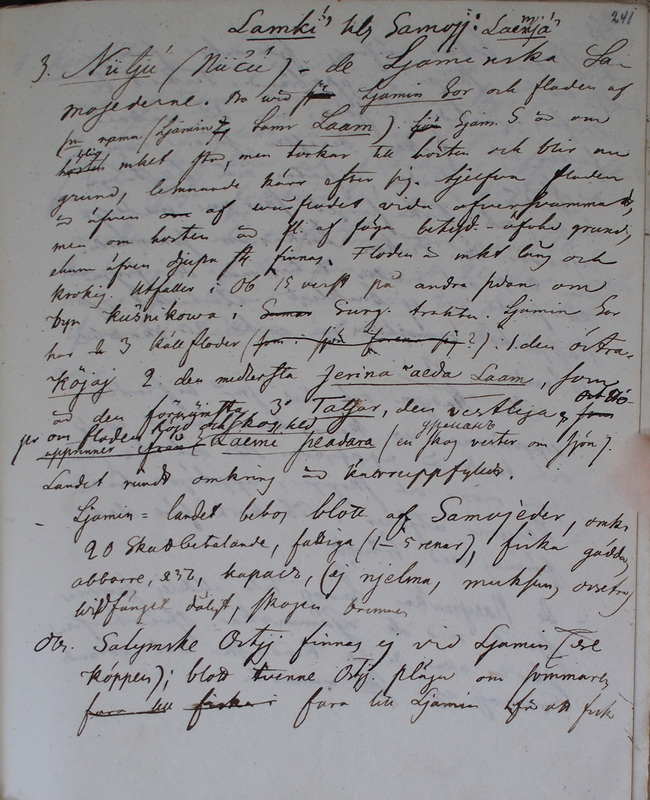Ethnographiska, historiska och statistiska anmärkningar. 241
Title
Ethnographiska, historiska och statistiska anmärkningar. 241
Description
| 3.
Niitju'
(Niiĉu?) - de Ljaminska Sa-Also known as Нитю, Нечу, Ничу, and possibly also Няць (Zenʹko-Nemčinova 2006: 17-52).
mojederne Lamkí' kls[kallas] Samojj.[Samojederne] Laenmjá' . Bo wid Ljamin Sor och floden af sma[samma] namn (Ljamin Sam[ojediska]. Laam). Ljam[in]. S[or]. är om hösten blir mket[mycket] stor, men torkar till hösten och blir nu grund, lemnade kärr efter sig. Sjelfva floden är äfven af wårfloder vida öfversvammad, men om hösten är fl[oden]. af föga betyd[else]. - öfvhv[öfverhufvud] grund, ehuru äfven djupa stl.[ställen] finnas. Floden är mkt[mycket] lång och krokig. Utfaller i Ob 15 verst på andra sidan om byn Kuŝnikowa i Surg[utska]. trakten.
Ljamin SorThe town of Surgut is situated on the river Obˈ at N61°14′40″ E73°23′19″. (TS)
har 3 källfloder ( som i i sjöar förena sig): 1. den östra Köjaj 2. den mellersta Jerina ~aeda Laam, som är den förnämsta 3. Tatjar, den vestliga, upprinner ifrån ger om floden höjd och skog, kld Laemi peadara (en skog vester om sjön, урманъ). Landet midt omkring är kärruppfylldt. |
3. The Niitju' (Niiĉu?) – the Ljamin Samoyeds or Lamkí (the Samoyeds call them Laenmjá'). They live at Ljamin Sor and by the river of the same name (the Ljamin in Samoyed Laam). The Ljamin Sor is very full, but dries up in the autumn, and the river bed becomes a swamp. The river itself is also widely flooded during the spring floods, but in autumn the river is of little significance – mainly ground, although there are also deep points. The river is very long and winding. It flows into the Ob 15 versts on the other side of the village of Kuŝnikowa in the Surgut the area. The Ljamin Sor has three source rivers: 1. the eastern Köjaj, 2. the middle Jerina ~aeda Laam, which is the foremost, and 3. The western Tatjar, originating from Laemi peadara (a forest west of the lake, urmanʹʹ). The land in the middle is full of marshes. |
| Ljamin=landet bebos blott af Samojeder, omkr[ing] 20 skattbetalande, fattiga (1-5 renar), fiska gäddar, abborre, язь,
Ru jazʹ ʻide, orfe’ (Leuciscus idus).
карась,
(ej njelma, muksun, osetr).Ru karasʹ ʻCrucian carp’ (Carassius carassius).
Wildfånget dåligt, skogen brunnen. |
The land of Ljamin is inhabited only by Samoyeds, with approximately 20 taxpayers, poor (one to five reindeer); they fish for pike, abborre, jazʹʹ, karasʹʹ ([they do not fish] njelma, muksun, osetr). Game hunting is not favourable; the forest is burnt. |
| Obs.
Salymske Ostjj.[Ostjaker]
finnas ej vid Ljamin (seKhanty living on the River Salym, which is near Ljamin. (Castrén 2019: 1064–1067)
Köppen);
blott tvenne Ostjj.[Ostjaker] pläga om sommarenKöppen wrote a supplement to the general instructions given to Castrén by the Russian Academy of Sciences. In that, he asks Castrén to clarify knowledge about the “notorious Ljamin Ssor and its inhabitants” (ueber den verrufenen Ljamin Ssor (Ляминъ Соръ) und dessen Antwohner) (Köppen 1844: 382).
fara till fiska i fara till Ljamin för att fiska. |
Obs. Salym Ostyaks not found at Ljamin (see Köppen); only two Ostyaks are in the habit of coming to Ljamin to fish in the summertime. |

